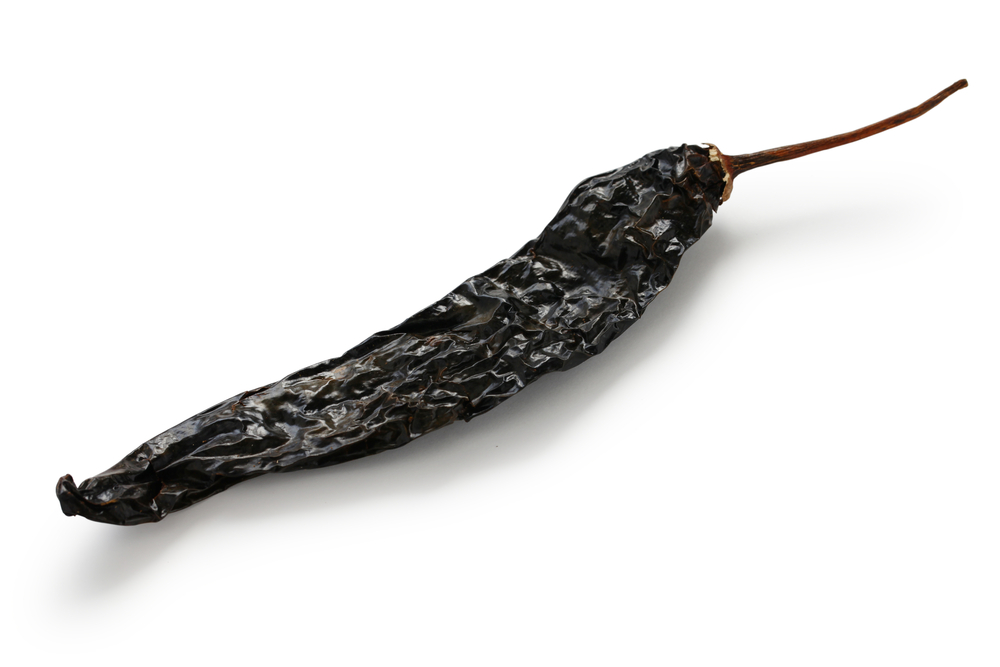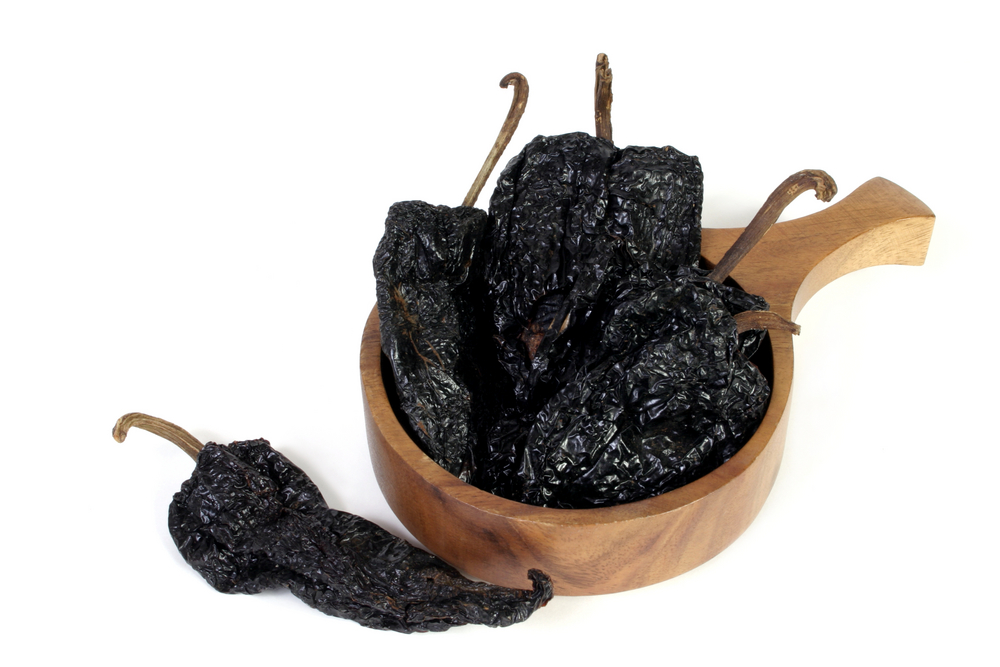Chile Pasilla is a famous Mexican pepper of the capsicum annuum species. Chile Pasilla is dried chilaca pepper. As the name suggests, it originated from the Puebla State of Mexico and forms a significant part of traditional Mexican recipes. The name chile Pasilla is Spanish, translating to 'little raisin' in English, due to its dark, wrinkled appearance.
What Are Chile Pasillas?
Chile Pasilla is elongated, thin, and curvy, with a length of 6-8 inches and a diameter of 1.5 inches. Sometimes, a mature Pasilla pepper pod may get to 9 inches long.
Chilaca peppers ripen to a dark-green color. When dried, they turn a dark, deep brownish-black shade that gives it the ‘chile negro’ name. Chile Pasilla is mild in heat and has a sweet, fruity, smoky taste with a touch of cocoa or coffee flavors.

Together with Ancho chilies, Molato, or Guajillo, this slender dried pepper makes the famous ‘holy trinity’ of dried Mexican peppers. It’s great on meats, tamales, salsas, and mole sauces.
How Spicy Is Chile Pasilla?
Despite its seemingly romantic name, chile Pasilla possesses a mild heat level, with a range of 250-2,500 SHUs on the Scoville scale. The heat level for the hottest Pasilla is the same as that of the mildest jalapeno pepper.
Ancho chiles (1,000-2,000 SHU) are less spicy than Pasilla chiles, while the dried Guajillo pepper (2,500-5,000 SHU) is much spicier.
Chile pasilla’s popularity comes from its distinctive flavor and not the heat level. If you’d love to make your dishes spicier, use chile Pasilla together with other heat-packed chilies.
What Is Chile Pasilla Used For?
Pasilla’s earthy, fruity flavor and mild-medium heat make it a favorite ingredient in diverse Mexican and Latin American dishes.
Chile pasilla is a member of ‘the holy trinity of Mexican chilies.’ It spices up traditional authentic dishes and sauces, including enchilada, hummus, and Mexican moles.
Soaked/rehydrated chile Pasilla gives a memorable sweet flavor to your hot sauces, homemade stews, salsas, and marinade pastes.
Since Pasilla pepper is also available in powder form, it goes well with Mexican rubs and homemade soups. Add the dried chile Pasilla to your Adobo Rojo de chiles to spice up your tacos, pork, chicken, or beef
A popular flame-roasted orgrilled Mexican fish dish, Pescado a la Talla calls for red or green sauce for dipping. The chile Pasilla brings a touch of berry-like sweetness to your red sauce and mild heat levels.
Aside from cooking, a recent study found the Pasilla pepper effective in preventing meat lipid oxidation. If you want to preserve your beef or pork, sprinkle some chile Pasilla powder on it or soak it in a marinade made from pureed chiles.
What Is The Difference Between Chile Pasilla And Chilaca Peppers?
Chile Pasilla and chilaca peppers refer to the same thing in different forms. Chilaca peppers are planted and harvested when fresh. When fully-ripened chilaca peppers are picked and dried, their name changes to chile Pasilla or chile negro.

Is Chile Pasilla The Same As Chile Ancho?
No. While both peppers share similarities, Chile Pasilla and Ancho chiles are different peppers.
Pasilla chile is dried chilaca, while chile Ancho refers to dried poblano peppers. Many U.S grocers confuse one for the other due to their wrinkled appearance, plus their blackish brown color when dried.
Pasilla chile (250-2,500 SHU) is spicier than Ancho chilies, which contain a mild heat ranging from 1,000-1,500 SHU. Ancho chile is an excellent option to add medium heat punch to your dishes, but the chilies can easily be used interchangeably.
Where To Buy Chile Pasilla
Chile Pasilla is available in powdered and dried forms. Unlike fresh chilaca peppers, Pasilla pepper can last longer, making it easy for you to get it in retail stores worldwide. In major supermarkets, check out the Mexican section of the international aisle for dried peppers.
Additionally, you can order dried chile Pasilla online. Depending on your where you live, you may also find it at your local farmers’ markets.
Substitutes For Pasilla Peppers
If you can’t find chile Pasilla, various chilies are great alternatives for your recipe. The other two members of ‘Holy trinity of Mexican peppers’ are top substitutes.
Ancho chile
Pasilla peppers share many similarities with Ancho chile. Both are dried and mild to medium heat. They can be used in powder form or rehydrated and pureed. If you’re keen on giving your dishes Pasilla’s earthy, fruity taste with less heat, Ancho chile works fine.
Mulato chile
Mulato chile also comes from the dried poblano pepper, but it is allowed to ripen on the plant longer, making it a bit hotter than ancho. Like Pasilla, Mulato chile has an earthy, chocolaty taste, making it a worthy substitute.
Guajillo pepper
Guajillo pepper has an earthy flavor closer to Pasilla’s but with a cranberry, tea-like flavor. Its heat level is almost like a jalapeno – far hotter than Pasilla. Try guajillo pepper if your recipes can do with a serious heat upgrade blended with an earthy taste.
Can You Grow Pasilla Peppers?
You can grow fresh chilaca peppers and dry them (in the sun, dehydrator, or oven) to make your Pasilla peppers.
In warm climates, chilaca peppers grow well as perennial crops, and you will harvest peppers for many growing seasons. In colder climates, it can be grown like any other chili pepper. Wait to plant or transplant outside until the chance of frost has passed, and make sure the plants have plenty of sun.

